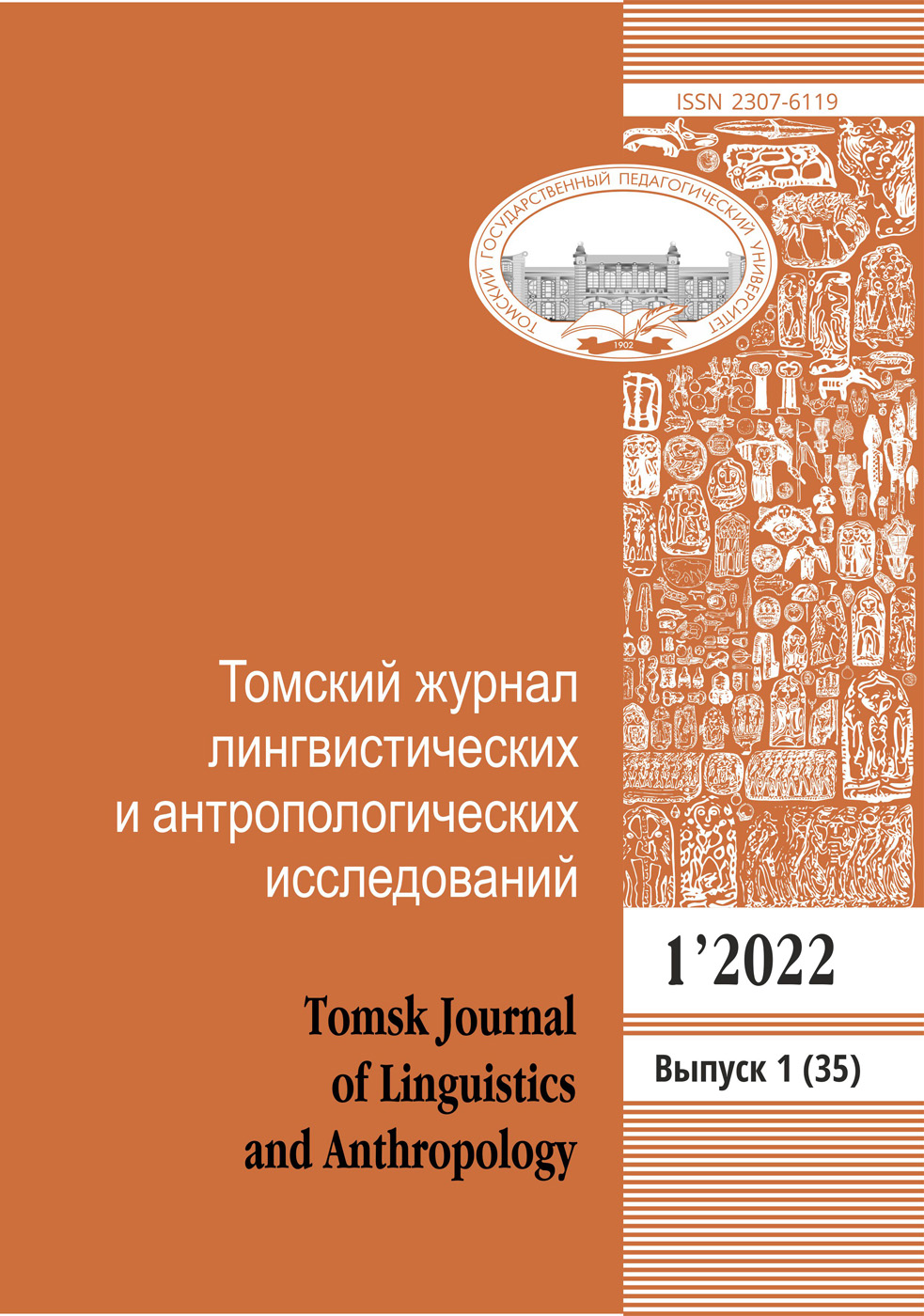FUNCTIONS OF THE “UNRELIABLE” NARRATOR IN RUSSIAN NOVEL OF THE 1920–1930S.
This article deals with the features of the narrative of Post-Symbolism novels. The investigation of the figure of the unreliable narrator is based on the texts by Vsevolod Ivanov, Constantine Vaginov, Yuri Olesha, and Vladimir Nabokov. The role that this kind of a narrative instance plays in realization of the narrative strategy of provocation is observed.
Keywords: narrative, narrator, storyteller, metaauthor, V. Nabokov, Yu. Olesha, K. Vaginov, L. Dobychin, I. Ehrenburg, V. Ivanov
References:
1. Auerbach E. Mimesis: Dargestellte Wirklichkeit in dear adendlandischen Literatur. 4 Aufl . Bern und Munchen: A. Francke, 1967. (Russ. ed.: Mimesis; per. s nem. Al. V. Mikhailova. Moscow, Progress Publ., 1976). 556 p.
2. Benjamin W. Gesammelte Schriften. Unter Mitwirkung von Theodor W. Adorno und Gershom Scholem hrsg. Von Rolf Tiedermann und Hermann Schweppenhauser. Frankfurt am Main, Suhrkamp, 19XX. (Russ. ed.: Maski vremeni. Esse o kulture i literature. Sost., predisl. i primech A. Belobratova; per s nem. i fr. A. Belobratov i dr. St. Petersburg, Symposium Publ., 2004).
3. Mandelshtam O. The end of the novel. Collected edition: in 2 volumes. Moscow: Khudozhestvennaya literatura Publ., 1990. Vol. 2. P. 201–205 (in Russian).
4. Smirnov I. P. The artistic sense and the evolution of the poetic systems. Moscow, Nauka Publ., 1977. 205 p. (in Russian).
5. Tyupa V. I. Literature and mentality. Moscow, Vest-consalting Publ., 2009. 276 p. (in Russian).
7. Olesha Yu. K. Envy. Olesha Yu. K. Envy. The three fat men. Short stories. Moscow, Vagrius, 1999. Pр. 17–127 (in Russian).
8. Nabokov V. Despair. Invitation to a beheading. Novels. Moscow, AST Publ., Kharkiv, Folio Publ., 1999 (in Russian).
10. Lachmann R. Erzahtle Phantastik: Zu Geschichte und Semantik des Phantastischen in der Literatur. Frankfurt am Main: Suhrkamp, 2002. (Russ. ed. Diskursy fantastichescogo. Moscow, Novoye literaturnoye obozreniye Publ., 2009). 372 p.
11. Luksemburg A. M. The insidious constructor of the play structures. Organisation of Nabokov’s metatext in the light of the play poethics theory. Nabokov’s collection: The art as a method. Ed. by M. A. Dmytrovskaya. Kaliningrad, Kaliningrad State University Publ., 2001. Pp. 3–19 (in Russian).
12. Witte G. Double Blind. Ьber Nabokovs Kinoroman. Gedдchtnis und Phantasma: die Welt der Slaven Sammelbдnde. Festschrift fьr Renate Lachmann. Hg. S. Frank, E. Greber, S. Schahadat, I. Smirnov. Band 13. Mьnchen, 2001. S. 574–593.
13. Zhilicheva G. A. The Narrative Strategies of Provoking and Inspiration in Russian Novel of 1920–1950s. Novosibirsk, NGPU Publ., 2012. 299 p. (in Russian).
14. Smirnov I. P. The visuals. Historical semantics of the cinema. St. Petersburg, Petropolis Publ., 2009. 402 p. (in Russian).
15. Loshchilov I. E. Olekhnovych’s buckle: L. Dobychin and the Russian cosmism. The philosophy of cosmism and Russian culture: proseedings of the international academic conference “Cosmism and Russian culture”. Belgrad, 2004. Pp. 229–235 (in Russian).
17. Segal D. Literature as a safeguard. Slavica Hierosolymitana. Jerusalem, 1981, vol. V–VI, pp. 218–237 (in Russian).
18. Kazarina T. V. Three epochs of the Russian Avant-garde. Samara, Samarskiy Universitet Publ., 2004. 620 p. (in Russian).
19. Burenina O. The literature is an island of dead (Nikolai Berdyayev, Konstantin Vaginov, Vladimir Nabokov). Symbolistic absurd and its traditions in Russian literature of the fi rst half of XX century. St. Petersburg: Aleteya Publ., 2005. Pp. 248–262 (in Russian).
20. Shindina O. V. Theatralisation of the narrative in K. Vaginov’s novel Goat Song. Theater, 1991, no. 11, pp. 161–171 (in Russian).
21. Zhilicheva G. A. The fun-fair (‘balagan’) methaphors in the narrative structure of Russian novels of the 1920–1930s. Tomsk State Pedagogical Bulletin, 2011, no. 7 (109), pp. 65–69 (in Russian).
22. Grigor’yeva N. Anima laborans: writer and labor in Russia 1920–1930s. St. Petersburg, Aleteya Publ., 2005. 294 p. (in Russian).
23. Podoroga V. Mimesis II. Moscow, Culturnaya revolutsiya Publ., 2011. 608 p. (in Russian).
24. Baranova K. V. The carnivalization in N. Erdman’s play “Mandate”. Tomsk State Pedagogical Bulletin, 2009, no. 4, pp. 80–89 (in Russian).
25. Golovchiner V. E. Comedy, comic and humor issues (“Days of the Turbiny” by Mikhail Bulgakov, “The Mandate” by N. Erdman). Tomsk State Pedagogical Bulletin, 2011, no. 7 (109), pp. 129–133 (in Russian).
26. Zhilicheva G. A. Russian comic novel of XX century. Novosibirsk, NGPU Publ., 2004. 149 p. (in Russian).
27. Lipovetskyi M. Paralogies. Transformation of the (Post)Modernist discourse in Russian culture of 1920–2000s. Moscow, Novoye Literaturnoye Obozrenie Publ., 2008. 848 p. (in Russian).
28. Gladkovskaya L. The talent full of zest. Leningrad, Khudozhestvennaya literatura Publ., 1983. 304 p. (in Russian).
29. Ivanov Vs. U. The return of Buddah. The amazing adventures of Fokin the tailor. U. Moscow, Pravda Publ., 1991. Pp. 133–476 (in Russian).
30. Dickens Ch. The posthumous papers of the Pickwick Club. Collectible edition in 30 volumes. Moscow, 1957. Vol. 2 (in Russian).
31. Frenzinskiy B. Serapions’ Fate. Neva, 1998, no. 11, pp. 24–36 (in Russian).
32. Muromsky V. P. ‘Serapion Brothers’ as a group literature phenomena. Russian literature, 1997, no. 7, pp. 81–88 (in Russian).
33. Etkind A. Sodom and Psyсhe. Moscow, Garant Publ., 1996. 414 p. (in Russian).
Issue: 11, 2013
Series of issue: Issue 11
Rubric: RUSSIAN AND WORLD LITERATURE: HISTORY AND POETICS, PROBLEMS OF TRANSLATION
Pages: 32 — 38
Downloads: 948





